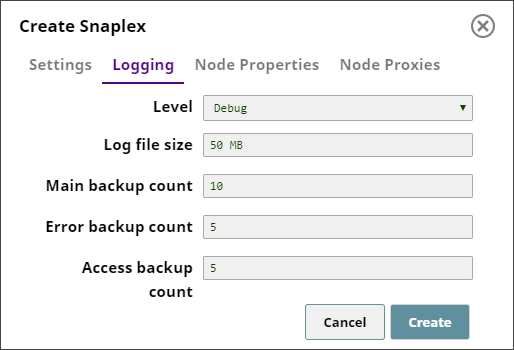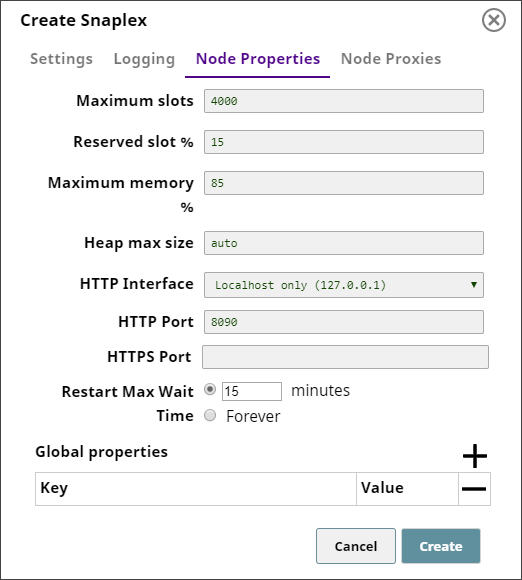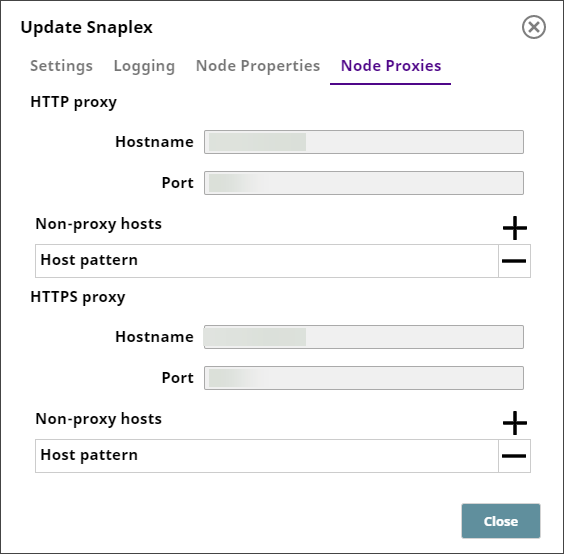In this article
|
To create a Snaplex, navigate to the target project in SnapLogic Manager, do one of the two following actions:
OR
The Create Snaplex dialog that appears contains the following tabs:
Click each tab to access the controls that help you define these properties for the Snaplex that you want to create.
Once you are done with these settings, click Create to create a new Snaplex.
Use the Create Snaplex > Settings dialog to enter basic settings associated with the Snaplex that you want to create.

SnapLogic supports the Slack messaging app within the SnapLogic platform communications, enabling you as an Org admin to add Slack channels and recipients for your SnapLogic communications. For details on adding Slack communications to your Org, see SnapLogic Notifications through Slack. |
| Snaplex Type | Specify whether the Snaplex you want to create is a standard Snaplex. Default value: Snaplex | |
|---|---|---|
| Name | The name for the Snaplex. The name must not exceed 100 characters.
Default value: No default value. | |
| Location | Specify whether the Snaplex must be created in the cloud or on premises. Select from the following options:
Default value: sidekick | |
| Environment | Enter the value used to configure the Snaplex nodes. Alphanumeric characters and the following special characters are allowed: Example: Dev-10 Default value: No default value.
| |
| Version | Specify the version of the SnapLogic Platform on which you want the Snaplex to run.
Default value: Default | |
Minimum nodes per Snaplex | The minimum number of nodes that must be kept alive even when there is no activity in the Snaplex. This property ensures that when a Pipeline that runs on the Snaplex is validated, at least one node is available to perform the validation. Minimum value: 1 Default value: 1 | |
| Email address for notifications | Lists the email addresses for notification if one of the Snaplex nodes does not respond for fifteen minutes. Example: testuser@snaplogic.com Default value: No default value. | |
| Slack Channel for notifications | Enter the Slack channels, separated by commas, for notification if one of the Snaplex nodes does not respond for fifteen minutes. Example: dev Default value: None | |
| Slack user for notifications | Enter the Slack recipients, separated by commas, for notification if one of the Snaplex nodes does not respond for fifteen minutes. Example: testuser Default value: None | |
| Load balancer | The URL of the load balancer for Triggered Task execution requests. Default value: No default value. Example: https://snaplexlb.mydomain.com | |
Ultra load balancer | The URL of the FeedMaster load balancer for Ultra Pipeline execution requests.
Default value: No default value. Example: https://ultralb.mydomain.com |
Snaplex nodes are typically configured using a slpropz configuration file, located in the $SL_ROOT/etc folder.
If you use the slpropz file as your Snaplex configuration, then:
Older Installations
If you have an older Snaplex installation and its configuration is defined in the global.properties file, then the Environment value must match the jcc.environment value In the JCC global.properties file. To migrate your Snaplex configuration to the slpropz mechanism, see Migrating Older Snaplex Nodes.
You should always configure your Snaplex instances using the slpropz file because you do not have to edit the configuration files manually. Changes to the Snaplex done through Manager are applied automatically to all nodes in that Snaplex.
For Snaplex triggered pipeline and for Ultra API calls, a load balancer needs to be configured. SnapLogic will provision the load balancer for Cloudplexes when the Ultra feature is enabled. For Groundplexes, the customer has to provision the load balancer. After the load balancer is provisioned, the load balancer URL needs to be configured in the Snaplex properties. This will ensure that task details show the load balancer URLs rather than pointing to the Snaplex nodes.
For Snaplexes that have feedmasters, the load balancer should point to the feedmaster nodes. The "Ultra load balancer" property should be updated to point to the load balancer URL. This will ensure that all tasks details will point to this load balancer. This includes ultra and triggered tasks.
For Snaplexes that do not have feedmasters, the load balancer should point to the JCC nodes. The "Load balancer" property should be updated to point to the JCC load balancer URL. The triggered tasks details page will point to this load balancer.
The load balancer is recommended to be configured with HTTPS enabled. If the load balancer URL is configured with HTTP instead of HTTPS, then the task details page will point to the load balancer for the HTTP URLs only. The HTTPS URLs will point to the snaplex nodes rather than pointing to the load balancer.
Check Groundplex Requirements#LoadBalancerGuidelines for more details about the load balancer configuration guidelines.
Use the Create Snaplex > Logging Settings popup to configure logs associated with the Snaplex that you want to create.

| Level | Specify the minimum level of logging–or the kind of details–that you want to enable for the new Snaplex. Available values:
Default Value: Debug | |
|---|---|---|
| Log file size | The maximum size of the log file to be created for the Snaplex. Default Value: 50 MB
| |
| Main backup count | The number of backup main log files that SnapLogic must maintain for the Snaplex. Default value: 10 | |
| Error backup count | The number of backup error log files that SnapLogic must maintain for the Snaplex. Default value: 5. | |
| Access backup count | The number of backup access log files that SnapLogic must maintain for the Snaplex. Default value: 5. |
Use the Create Snaplex > Node Properties tab to configure the nodes associated with the Snaplex that you want to create.

| Maximum slots | Each Snap in a Pipeline consumes a slot; so Pipelines can only be executed on nodes where the number of slots in use is below this threshold. Otherwise, they will fail or queued, depending on how they were executed. The number of slots in use corresponds to the number of active threads on a node, which can be viewed in the Snaplex Health dashboard. Default Value: 4000 A heuristic to use is that 2000 slots can be allocated per 8GB of RAM available on each Snaplex node. So for nodes with 16GB of RAM, use 4000 as the slot count. Reserved slots are used when a Pipeline or validation is executed manually from SnapLogic Designer. If no slots are reserved, then these interactive Pipeline executions—Pipeline executions run from Designer for testing or validation purposes—can be blocked by long running executions. You can adjust this setting based on your experience if the default value is not optimal. To reserve more slots for interactive sessions, set your value lower. If the Snaplex is not being used for interactive Pipeline building, set this value higher. | |
|---|---|---|
| Reserved slot % | The percentage of slots that you want to reserve on a node for Pipelines executed through the Designer tab. Pipelines executed using Tasks or the ForEach Snap will not have access to these slots.
Default value: 15 | |
| Maximum memory % | The memory threshold at–and above–which no more Pipelines can be assigned to a node.
Default value: 85 | |
| Heap max size | Groundplex only. The maximum JVM heap size. Default value: auto (meaning that SnapLogic will automatically set the max heap size based on the available machine memory). | |
| HTTP Interface | Groundplex only. Specify the location from which the Snaplex node can accept HTTP network connections. The following options are available:
Default Value: Localhost only (127.0.0.1) | |
| HTTP Port | Groundplex only. The HTTP port on which the Snaplex node listens for connections. Default Values: 8090 for a JCC node and 8091 for a FeedMaster. | |
| HTTPS Port | Groundplex only. The HTTPS port on which the Snaplex node listens on for connections. Default Values: 8081 for a JCC node and 8084 for a FeedMaster. | |
| Restart Max Wait Time | The maximum wait time before restarting a node. Default Value: 15 minutes | |
| Global Properties (Key/Value pairs) | Groundplex only. Internal configuration options. Do not edit these values without contacting SnapLogic Customer Support. Default Value: No default value. |
Use the Node Proxies tab to control how the nodes communicate with an HTTP/HTTPS proxy server to communicate with the outside world. The Groundplex nodes must have been setup to use an .slpropz configuration file before changes to these properties will take effect. If you make changes that affect the software configuration, but there are nodes in the Snaplex that are not setup to use a .slpropz configuration file, a warning dialog will appear with a listing of the unmanaged nodes. See the Downloads section in Updating a Snaplex for more information on setting up a node to use this configuration mechanism.

| HTTP proxy | Configuration details associated with the HTTP proxy server. |
|---|---|
| Hostname | The URL of the HTTP proxy host. Example: 172.0.10.162 Default: No default value. |
| Port | The port number on which the HTTP proxy host listens. Example: 3127 Default: No default value. |
| Non-proxy hosts: Host pattern | The hostnames or IP addresses that should be contacted directly instead of through the proxy. Patterns may start or end with a * for wildcards. |
| HTTPS proxy | Configuration details associated with the HTTPS proxy server. |
| Hostname | The URL of the HTTPS proxy host. Example: 172.0.10.162 Default value: No default value. |
| Port | The port number on which the HTTPS proxy host listens. Example: 3127 Default: No default value. |
| Non-proxy hosts: Host pattern | The hostnames or IP addresses that should be contacted directly instead of through the proxy. Patterns may start or end with a * for wildcards. |